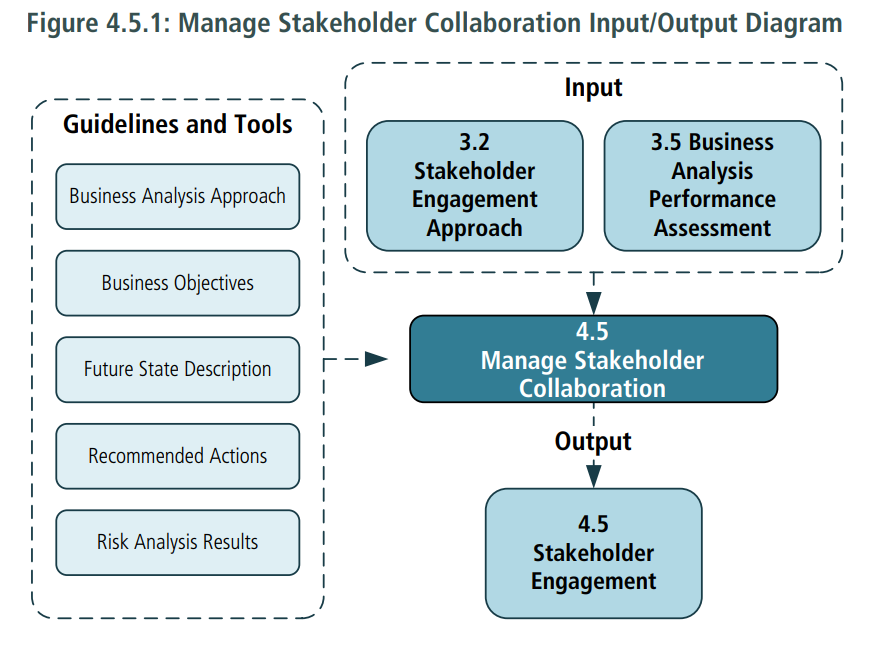4.5.1 Purpose
The purpose of Manage Stakeholder Collaboration is to encourage stakeholders to work towards a common goal.
4.5.2 Description
Business analysis work lends itself to many collaboration opportunities between groups of stakeholders on the business analysis work products. Stakeholders hold various degrees of influence and authority over the approval of work products, and are also an important source of needs, constraints, and assumptions. As the business analysis work progresses, the business analyst identifies stakeholders, confirms their roles, and communicates with them to ensure that the right stakeholders participate at the right times and in the appropriate roles.
Managing stakeholder collaboration is an ongoing activity. Although managing stakeholder collaboration begins once stakeholders have been identified and analyzed, new stakeholders may be identified at any point during an initiative. As new stakeholders are identified, their role, influence, and relationship to the initiative are analyzed. Each stakeholder’s role, responsibility, influence, attitude, and authority may change over time.
The more significant the impact of the change or its visibility within the organization, the more attention is directed to managing stakeholder collaboration. Business analysts manage stakeholder collaboration to capitalize on positive reactions and mitigate or avoid negative reactions. The business analyst should constantly monitor and assess each stakeholder’s attitude to determine if it might affect their involvement in the business analysis activities.
Poor relationships with stakeholders can have many detrimental effects on business analysis, including:
- failure to provide quality information,
- strong negative reactions to setbacks and obstacles,
- resistance to change,
- lack of support for, and participation in, business analysis work, and
- business analysis information being ignored.
These effects can be modified in part through strong, positive, and trust-based relationships with stakeholders. Business analysts actively manage relationships with stakeholders who:
- provide services to the business analyst, including inputs to business analysis tasks and other support activities,
- depend on services provided by the business analyst, including outputs of business analysis tasks, and
- participate in the execution of business analysis tasks.
4.5.3 Inputs
- Stakeholder Engagement Approach: describes the types of expected engagement with stakeholders and how they might need to be managed.
- Business Analysis Performance Assessment: provides key information about the effectiveness of business analysis tasks being executed, including those focused on stakeholder engagement.

4.5.4 Elements
.1 Gain Agreement on Commitments
Stakeholders participate in business analysis activities that may require time and resource commitments. The business analyst and stakeholders identify and agree upon these commitments as early in the initiative as possible. The specific details of the commitments can be communicated formally or informally, as long as there is explicit understanding of the expectations and desired outcomes of the commitment.
There may be dialogue and negotiation regarding the terms and conditions of the commitments. Effective negotiation, communication, and conflict resolution skills are important to effective stakeholder management (see Negotiation and Conflict Resolution (p. 210)).
.2 Monitor Stakeholder Engagement
Business analysts monitor the participation and performance of stakeholders to ensure that:
- the right subject matter experts (SMEs) and other stakeholders are participating effectively,
- stakeholder attitudes and interest are staying constant or improving,
- elicitation results are confirmed in a timely manner, and
- agreements and commitments are maintained.
Business analysts continually monitor for such risks as:
- stakeholders being diverted to other work,
- elicitation activities not providing the quality of business analysis information required, and
- delayed approvals.
.3 Collaboration
Stakeholders are more likely to support change if business analysts collaborate with them and encourage the free flow of information, ideas, and innovations.
Genuine stakeholder engagement requires that all stakeholders involved feel that they are heard, their opinions matter, and their contributions are recognized.
Collaboration involves regular, frequent, and bi-directional communication.
Collaborative relationships help maintain the free flow of information when obstacles and setbacks occur and promote a shared effort to resolve problems and achieve desired outcomes.
4.5.5 Guidelines and Tools
- Business Analysis Approach: describes the nature and level of collaboration required from each stakeholder group to perform planned business analysis activities.
- Business Objectives: describe the desired direction needed to achieve the future state. They can be used to focus diverse stakeholders on a common vision of the desired business outcomes.
- Future State Description: defines the desired future state and the expected value it delivers which can be used to focus diverse stakeholders on the common goal.
- Recommended Actions: communicating what should be done to improve the value of a solution can help to galvanize support and focus stakeholders on a common goal.
- Risk Analysis Results: stakeholder-related risks will need to be addressed to ensure stakeholder collaboration activities are successful.
4.5.6 Techniques
- Collaborative Games: used to stimulate teamwork and collaboration by temporarily immersing participants in a safe and fun situation in which they can share their knowledge and experience on a given topic, identify hidden assumptions, and explore that knowledge in ways that may not occur during
the course of normal interactions. - Lessons Learned: used to understand stakeholders’ satisfaction or dissatisfaction, and offer them an opportunity to help improve the working relationships.
- Risk Analysis and Management: used to identify and manage risks as they relate to stakeholder involvement, participation, and engagement.
- Stakeholder List, Map, or Personas: used to determine who is available to participate in the business analysis work, show the informal relationships between stakeholders, and understand which stakeholders should be consulted about different kinds of business analysis information.
4.5.7 Stakeholders
- All stakeholders: all types of stakeholders who might be involved in collaboration during change.
4.5.8 Outputs
- Stakeholder Engagement: willingness from stakeholders to engage in business analysis activities and interact with the business analyst when necessary
